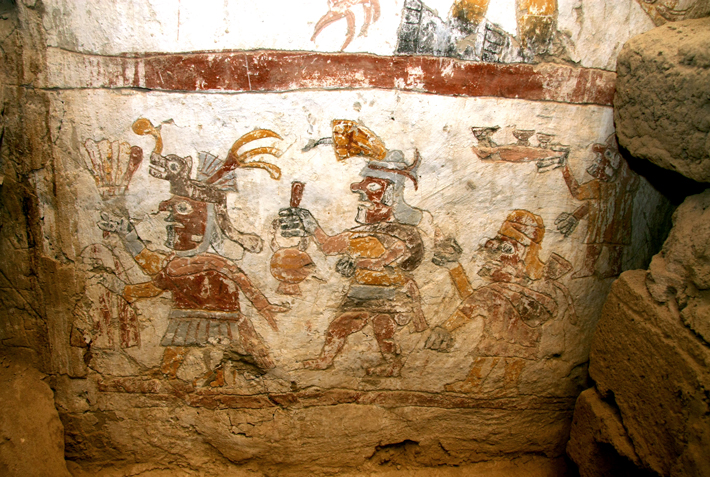archeology
The front of the Autumn 1951 issue of Archeology includes an emotional scene of close battle between two men, teeth uncovered, faces brilliant red with effort, articles of clothing flying, pulling each other's hair so brutally that every hold the tore out forelock of his enemy. Made by the craftsman Pedro Azabache, this cover is a reproduction of a divider painting at the site of Pañamarca on the northwest bank of Peru, done not long after the work's rediscovery. Wall painting A delineates a challenge between Ai-Apaec, the fanciful saint revered by the Moche culture, which prospered in this area between about A.D. 200 and 900, and his twin or twofold. Despite the fact that Pañamarca's great destroys on a rock outcropping in the lower Nepeña River Valley were outstanding in the main portion of the twentieth century, and had been depicted by explorers in the late nineteenth century, just a couple of articles about the site had been distributed and next to no had been said in regards to its divider compositions. In this way, when American classicist Richard Schaedel landed there in 1950, he trusted that any depictions he may discover would be fragmentary, best case scenario. Once there, in any case, he soon found that Pañamarca's adobe structures had been totally shrouded in polychrome wall paintings. In a solitary week—initially got ready for five days, the excursion was expanded when more wall paintings and a gathering of entombments were found—Schaedel and his five-man group recorded the battle scene, as well as found new wall paintings of what he recognized as an extensive feline evil presence and a human fowl. On the dividers of a vast square, they archived a 30-foot-long structure demonstrating a parade of warriors and ministers wearing an outfit with cut molded backflaps known to have been a piece of Moche conciliatory customs.
In spite of the fact that in under perfect condition after over 1,000 years, the wealth and sudden condition of conservation of Pañamarca's wall paintings astonished and charmed Schaedel. Be that as it may, it likewise concerned him. In his article about the site for Archeology, he expresses, "We trust that this depiction [of the paintings] will fill in as a convenient note and cautioning to admirers of craftsmanship and prehistoric studies in Peru and somewhere else that this rich wellspring of clear wall painting improvement, which today just anticipates the tolerance of the paleologist to uncover, may tomorrow be unavoidably pulverized. In the event that these still unrevealed records of the human soul are not to be always lost to us, we should continually remember two goals: as archeologists, to dedicate our consideration above all else to the sufficient documentation of delicate works of art; and to make among people in general all in all an attention to their stylish and in addition their narrative esteem, with the goal that the present lack of concern towards their conservation might be supplanted by a feeling of commitment to their insurance."
Over the over a long time since Schaedel's work at Pañamarca, it was generally accepted that his cautions had been overlooked or overlooked, and that the surviving wall paintings had fallen into demolish. Almost no hands on work was directed after Schaedel's unearthings and work by Duccio Bonavia later in the 1950s, and just a couple of new sketches were found. Whenever paleontologist and workmanship student of history Lisa Trever of the University of California, Berkeley, worked in Pañamarca in 2010 alongside her Peruvian partners Jorge Gamboa, Ricardo Toribio, and Ricardo Morales, she wasn't extremely confident. "I was negative when we started, assuming that a large portion of the wall paintings that had been found before had been demolished, so we set out to delineate the artistic creations had been and to contextualize what remained," she says. "Be that as it may, when we started to burrow, we were stunned that so much had made due from the before unearthings." What was significantly all the more astounding was that quite a lot more stayed in situ, in place, and unexcavated. "We were soon taking a gander at things that nobody had seen since A.D. 780, when parts of the site were intentionally covered," says Trever. "We ran in with a feeling that Pañamarca was a site of lost landmarks and lost magnum opuses of the antiquated Peruvian past, and were astonished to discover that not all things be lost by any means."
Congratulations @jason482! You have completed some achievement on Steemit and have been rewarded with new badge(s) :
Click on any badge to view your own Board of Honor on SteemitBoard.
For more information about SteemitBoard, click here
If you no longer want to receive notifications, reply to this comment with the word
STOPnice post..thanks for sharing with us
Brilliant post
Archaeology includes an emotional scene.
Gd
good post....keep it.
Such a cool photo shoots. Lovely post